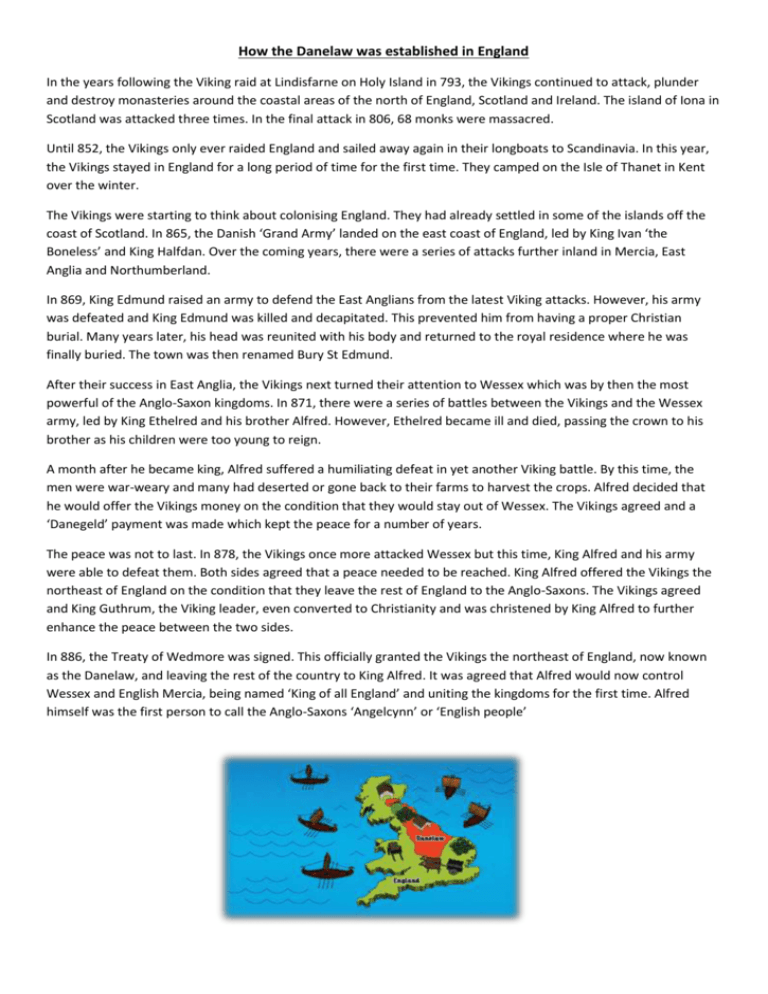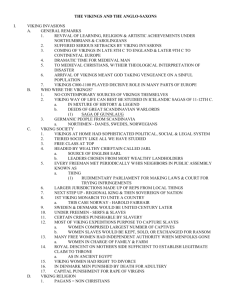How the Danelaw was established in England
advertisement

How the Danelaw was established in England In the years following the Viking raid at Lindisfarne on Holy Island in 793, the Vikings continued to attack, plunder and destroy monasteries around the coastal areas of the north of England, Scotland and Ireland. The island of Iona in Scotland was attacked three times. In the final attack in 806, 68 monks were massacred. Until 852, the Vikings only ever raided England and sailed away again in their longboats to Scandinavia. In this year, the Vikings stayed in England for a long period of time for the first time. They camped on the Isle of Thanet in Kent over the winter. The Vikings were starting to think about colonising England. They had already settled in some of the islands off the coast of Scotland. In 865, the Danish ‘Grand Army’ landed on the east coast of England, led by King Ivan ‘the Boneless’ and King Halfdan. Over the coming years, there were a series of attacks further inland in Mercia, East Anglia and Northumberland. In 869, King Edmund raised an army to defend the East Anglians from the latest Viking attacks. However, his army was defeated and King Edmund was killed and decapitated. This prevented him from having a proper Christian burial. Many years later, his head was reunited with his body and returned to the royal residence where he was finally buried. The town was then renamed Bury St Edmund. After their success in East Anglia, the Vikings next turned their attention to Wessex which was by then the most powerful of the Anglo-Saxon kingdoms. In 871, there were a series of battles between the Vikings and the Wessex army, led by King Ethelred and his brother Alfred. However, Ethelred became ill and died, passing the crown to his brother as his children were too young to reign. A month after he became king, Alfred suffered a humiliating defeat in yet another Viking battle. By this time, the men were war-weary and many had deserted or gone back to their farms to harvest the crops. Alfred decided that he would offer the Vikings money on the condition that they would stay out of Wessex. The Vikings agreed and a ‘Danegeld’ payment was made which kept the peace for a number of years. The peace was not to last. In 878, the Vikings once more attacked Wessex but this time, King Alfred and his army were able to defeat them. Both sides agreed that a peace needed to be reached. King Alfred offered the Vikings the northeast of England on the condition that they leave the rest of England to the Anglo-Saxons. The Vikings agreed and King Guthrum, the Viking leader, even converted to Christianity and was christened by King Alfred to further enhance the peace between the two sides. In 886, the Treaty of Wedmore was signed. This officially granted the Vikings the northeast of England, now known as the Danelaw, and leaving the rest of the country to King Alfred. It was agreed that Alfred would now control Wessex and English Mercia, being named ‘King of all England’ and uniting the kingdoms for the first time. Alfred himself was the first person to call the Anglo-Saxons ‘Angelcynn’ or ‘English people’











